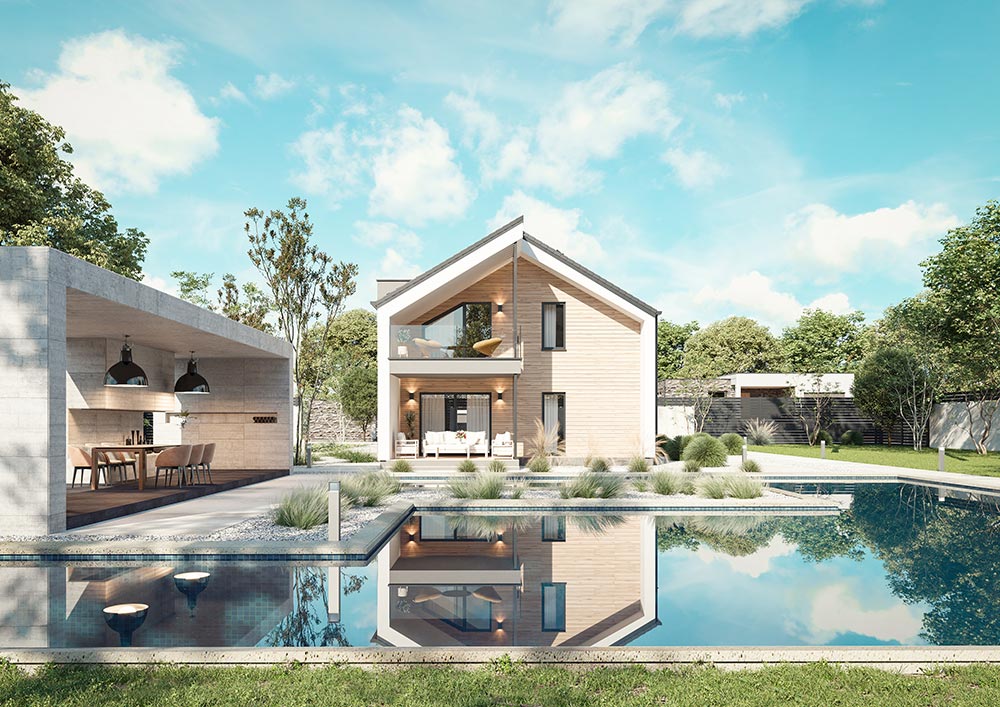The Core of Our Homes
The Core of Our Homes
The main difference between traditional construction and low-energy prefabricated homes lies in the building process itself.

While conventional homes are built entirely on-site — often exposed to weather conditions and relying heavily on manual labor — prefabricated houses are manufactured in controlled factory environments. All major components, such as walls, floors, and ceilings, are pre-assembled with integrated insulation, installations, and finishes.
Once delivered to the construction site, these elements are quickly and efficiently assembled, significantly reducing build time and minimizing the risk of error.
In terms of durability, there is no significant difference between traditional and prefabricated homes, but low-energy houses offer clear advantages in energy efficiency — leading to substantial savings on heating and cooling. Additional systems such as solar panels, heat pumps, and rainwater collection further enhance their value, making them not only modern and efficient, but also sustainable for the future.
Advantages of Low-Energy Construction
Low-energy construction represents a modern and efficient approach to residential building that surpasses traditional construction methods in many aspects. Instead of conventional materials such as brick, top-tier energy-efficient materials are used to ensure long-term self-sufficiency of the building.
Energy Efficiency
Energy consumption for heating and cooling can be reduced by up to five times compared to traditional construction. This results in significantly lower monthly utility bills and excellent long-term cost-effectiveness.
Enhanced Safety and Durability
Thanks to wooden structural elements clad in non-combustible or low-combustible materials, low-energy homes offer greater resistance to earthquakes and fire, contributing substantially to overall residential safety.
Dry Construction – Free from Moisture and Mold
The construction process is carried out entirely without wet work, eliminating the risk of moisture buildup, damp walls, and mold. This ensures a high level of comfort and a healthy indoor environment.
Eco-Friendly and Healthy Materials
By using natural and environmentally friendly materials, low-energy houses provide a healthy, high-quality, and comfortable living space, making them an ideal solution for modern living.
Longevity
The durability of these buildings depends largely on construction quality and regular maintenance. With proper care, low-energy prefabricated houses can last 150 years or more, making them fully comparable to traditional brick-built homes.
Premium Features – Added Value
With high-quality, modern furniture, and premium bathroom ceramics and sanitary ware, you get a fully furnished property with outstanding aesthetics and functionality. Such a home is an excellent investment, as you will always easily find a buyer—whether you decide to sell after renting, living in the house, or simply out of a desire for change.
Low-energy construction represents a modern and efficient approach to residential building that surpasses traditional construction methods in many aspects. Instead of conventional materials such as brick, top-tier energy-efficient materials are used to ensure long-term self-sufficiency of the building.
Energy Efficiency
Energy consumption for heating and cooling can be reduced by up to five times compared to traditional construction. This results in significantly lower monthly utility bills and excellent long-term cost-effectiveness.
Enhanced Safety and Durability
Thanks to wooden structural elements clad in non-combustible or low-combustible materials, low-energy homes offer greater resistance to earthquakes and fire, contributing substantially to overall residential safety.
Dry Construction – Free from Moisture and Mold
The construction process is carried out entirely without wet work, eliminating the risk of moisture buildup, damp walls, and mold. This ensures a high level of comfort and a healthy indoor environment.
Eco-Friendly and Healthy Materials
By using natural and environmentally friendly materials, low-energy houses provide a healthy, high-quality, and comfortable living space, making them an ideal solution for modern living.
Longevity
The durability of these buildings depends largely on construction quality and regular maintenance. With proper care, low-energy prefabricated houses can last 150 years or more, making them fully comparable to traditional brick-built homes.
Premium Features – Added Value
With high-quality, modern furniture, and premium bathroom ceramics and sanitary ware, you get a fully furnished property with outstanding aesthetics and functionality. Such a home is an excellent investment, as you will always easily find a buyer—whether you decide to sell after renting, living in the house, or simply out of a desire for change.